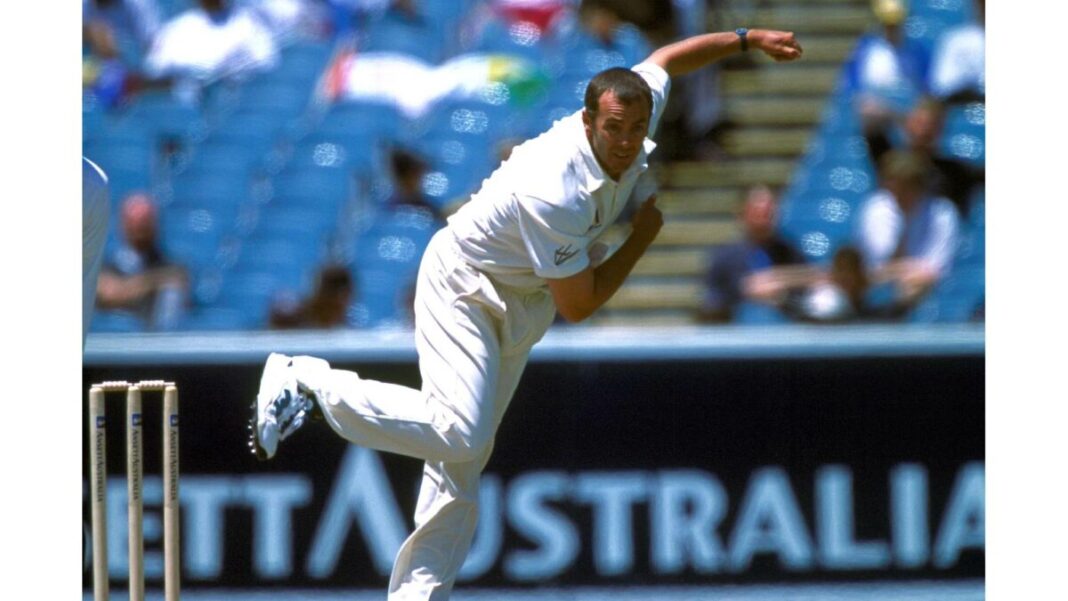When it comes time to talking about late-bloomers in Australian cricket, Colin Miller’s unique journey to a baggy green cap is one of the most remarkable of all time.
His time at the top was only brief – two and a half years between his first and last match for Australia – but it was spectacular, given that he was named Test Player of the Year in a team filled with all-time greats.
“Funky” got the nod from a team stacked with Allan Border Medallist Steve Waugh, Glenn McGrath, Shane Warne, Brett Lee, Adam Gilchrist, Mark Waugh, Justin Langer and Damien Martyn which broke the world record for 16 wins in a row.
He was 34 by the time he finally broke into the Australian team in 1998 through the sheer weight of wickets for Tasmania.
Miller had played just six matches for Tassie just a couple of summers beforehand and looked to be coming to the end of the first-class road, which had detoured through Holland, the Lancashire League as well as three states.
His modest return of 14 wickets at 49.75 and a strike rate of 81.9 suggested he was out of his depth and on the wrong side of 30, the journeyman’s future prospects looked bleak.
In 1996-97, he made great strides forward with 32 from 10 matches at 35.7 but his strike rate was similar and he was not even close to being on the national selectors’ radar.
Then, as legend has it, he was struggling to shake off an ankle injury so during a club game for Lindisfarne Cricket Club in Hobart he opted to send down a few off-spinners to avoid doing any further damage.
He tells the tale that he was on the princely sum of a hundred bucks a week so he thought he couldn’t sit out the match so he rolled out the tweakers that he had often trialled in the nets.
The first batter he dismissed in Shield cricket after a mid-innings switch to spin was none other than Matthew Hayden and he never looked back.
Becoming the most unlikely of “all-rounders”, his dual ability to take the new ball to bowl seamers then switch to tweakers was not just a novelty act – in the 1997-98 season, he took 67 wickets at 24.5.
The next best wicket-taker was Western Australian left-arm swing bowler Brendon Julian, who was a distant second with 39.
Miller joked that he “wasted 13 years bowling medium pace”.
With the Aussies heading to Pakistan before the 1998 home summer, Shane Warne was unavailable due to shoulder surgery so Miller was given the nod for the first Test as the back-up to Stuart MacGill.
Eight wickets, including Salim Malik as his first victim from an outswinger, across three matches at 41.1 was a solid but not spectacular belated start to his international career and after good but again not great cameos in three of the five home Ashes Tests later in the summer, he gained a seat on the plane to the Caribbean for the showdown with the West Indies.
He was a tourist for the first three matches but with Warne struggling to make an impact for one of the few times of his career in his return from shoulder surgery, captain Steve Waugh and coach Geoff Marsh made the decision to drop the spin king with Miller getting called up.
Miller filled his role with three wickets for the match but still had not cemented a spot.
After seven wickets for the match in the famous Kandy Test against Sri Lanka in 1999 when Waugh and Jason Gillespie were hospitalised after a sickening collision, Miller then struggled in the next two games on tour and again it looked like his flirtation with international cricket would be over.
New Zealand’s grassy wickets are not renowned for helping spinners but Miller, who opened the bowling in one Test ahead of Brett Lee, thrived in the trans-Tasman tour in early 2000.
He bagged his first five-wicket haul of 5-55, overshadowing no less than Lee, Warne and Glenn McGrath, to bowl the Aussies to a 62-run win in Auckland.
Miller followed that up with two more five-fors in a player of the match performance in his next Test the following summer against the West Indies, dismissing Brian Lara in each innings.
Despite playing three of the five matches, his 20 wickets was only one behind McGrath as the most in the series.
Everyone wanted a piece of “Funky”. His penchant for dying his hair all sorts of colours and happy go lucky demeanour was at odds with most of his straight-laced teammates but spinners are a different breed.
The outlandish veteran was a surprising but popular winner of the Test player of the year award at the AB Medal night, still sporting the blue hair which sent Windies skipper Courtney Walsh into fits of hilarity when he tried facing up to him.
But on the tour of India a couple of weeks later, the Aussies picked Damien Fleming and then Michael Kasprowicz ahead of Miller with Warne the sole spinner.
It worked when they won the series opener but after the Australian team’s run of 16 straight Test wins in a row came to a barely believable end in the second match, he was recalled for the series finale.
He toiled hard for 46 overs in the first innings, taking 3-160, as India amassed 501 to lead by 110, and then claimed 3-41 in the second dig as the Aussies nearly defended a flimsy victory target of 155 before going down by just two wickets.
Colin “Funky” Miller bowls at Melbourne in 2000. (Photo: Robert Cianflone/ALLSPORT)
And just like that, Miller’s career in the baggy green was over.
He went on the Ashes trip to England but was only used in first-class fixtures and when the Kiwis and Proteas came to Australia the following home summer, MacGill’s SCG cameo in the final Test of the season was the only time a spinner apart from Warne was used.
Miller, by this stage, had returned to his hometown of Melbourne, but his form for Victoria was waning – just six wickets at 72 in four appearances.
In the off-season, Victoria’s straight-shooting coach David Hookes informed Miller that he would not be required the following summer, bringing down the curtain on one of the most unusual careers in Australian cricket history.
“Certainly the last four years exceeded all expectations, from the time I turned 34 it all changed for me for the better,” Miller said at the time.
“I had a great time with the Australian team, it’s more than I could have expected.
“The 18 Tests for Australia, I don’t think I had a bad game.
“I know my figures stack up pretty well for what I did – coming in at an older age I can hold my head pretty high.”
These were the words of someone who had cherished their unexpected time in the sun in the twilight of their career, thankful for making it to the top, not bitter about the abrupt way it ended.
All up, in his 84 Sheffield Shield matches spanning a 16-year stretch with South Australia, Tasmania and Victoria, he pouched 304 wickets from 84 matches with 18 five-wicket hauls.
That alone would have been a very fine career but due to his brief but memorable Test career, he will forever hold an atypical place in Australian cricket folklore.

